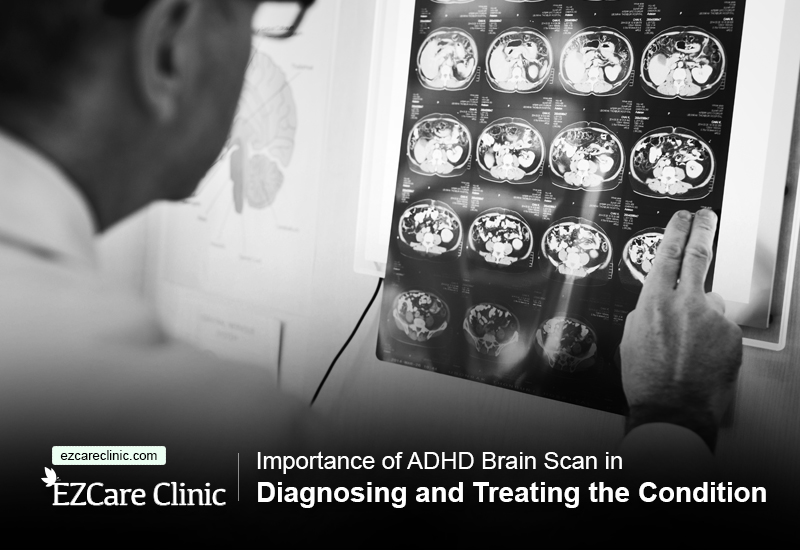Attention-deficit hyperactivity disorder affects many children worldwide and often persists into adulthood. The condition affects a child’s development and emotional patterns. While treatments will not cure the condition, early diagnosis facilitates behavioral intervention, and medication can make a big difference.
ADHD impacts performance. Children with ADHD struggle with insufficient self-esteem and difficulty sustaining relationships. And even though the symptoms decrease with age, some never completely outgrow ADHD symptoms. However, with help, they can learn tactics to manage the symptoms and succeed.
Treat AHDH symptoms effectively by clicking the button below!
ADHD Symptoms
There are no clear causes of ADHD. Many factors, including genetics, environment, and central nervous system issues, play a key role as well.
Children with the condition display abnormal levels of impulsive behavior and agitation. They have trouble focusing on a single task or remaining still for substantive amounts of time.
There are 3 types of ADHD. Combined ADHD is a mix of hyperactive and inattentive symptoms. Predominantly impulsive ADHD people majorly display hyperactive symptoms. Then there is the predominantly inattentive who majorly struggle with focusing.
ADHD affects boys and girls differently. In most cases, boys with ADHD tend to be more hyperactive, while girls may be silently inattentive.
ADHD symptoms start as early as age 3 and become full-blown at age 12. The symptoms range from mild to moderate and severe and often persist into adulthood.
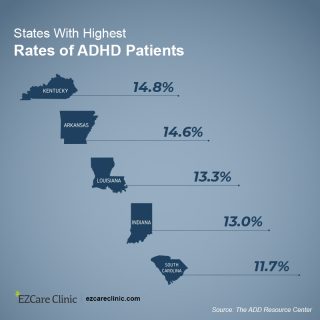
States With Highest Rates of ADHD Patients
Importance of ADHD Brain Scans in Diagnosis and Treatment
One big issue with ADHD treatment is the lack of correct ways to diagnose the condition well.
ADHD also presents just as normal developmental behavior at first. For example, typically, most preschoolers have a short attention span and are naturally hyperactive, just like ADHD kids. Therefore, many parents ignore ADHD symptoms in their kids, brushing it off as normal behavior.
But thanks to the advancement in brain scanning technologies, society is changing its views on ADHD. Modern brain scans reveal brain functioning. Doctors can now map out brain patterns and areas and distinguish healthy brain activity from unhealthy and even interactivity. These scans help form better strategies against the symptoms of ADHD.
What Is a Brain Scan?
A brain scan involves the use of technology to take a deeper look at brain structure and functioning. Well-known brain scanning techniques include:
- Functional magnetic resonance imaging (FMRI)
- Magnetic resonance imaging (MRI)
- Magnetoencephalography
- Event-related optical signal
- Diffuse optical imaging
- Computed axial tomography
- Positron emission tomography
- Single-photon emission computed tomography (SPECT)
Treat ADD/AHDH symptoms by clicking the button below!
-
Brain scans reveal brain functioning.
Modern techniques like SPECT scans are useful in mapping brain functioning. Doctors can now tell what is healthy brain activity and what is not by taking a deeper look inside a person’s brain. This helps select the best medication and behavioral intervention for ADHD.
Apart from monitoring brain disorders, SPECT is also useful in identifying heart disorders, bone problems, head injuries, and drug abuse.
-
Brain scans are useful in making an accurate diagnosis.
There are many ADHD tests online, but none is as accurate as modern brain scans. Most tests just match mental disorders to symptoms and how patients react. But this is bound to result in inaccuracies because they don’t take a look at how a person’s brain is working.
Brain scans help avoid inaccuracies by identifying which areas of the brain are less active or more active. Most ADHD conditions can be helped once the cause is identified.
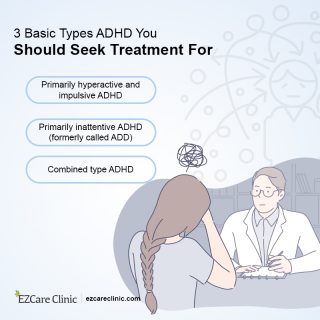
3 Basic Types ADHD You Should Seek Treatment For
Objective Diagnosis
Most people only believe what they can see, and what better way to get ADHD patients to take their condition seriously and seek treatments than with an image of their brain?
Brain scans reveal all, helping practitioners stay objective and prescribe the proper treatment. Many people worldwide are accepting brain scans because they are cost-effective, efficient, and lead to a better assessment.
No longer do psychiatrists have to rely on subjective assessments to diagnose mental conditions. Diagnosis based on physician assessment and client reports is not always accurate. Given the same client, multiple consultants could land at various conclusions if they rely solely on subjective assessment.
-
Brain scans help break denial.
Many people never want to accept that something is not right until they see it with their own eyes. This is the case with ADHD patients too. The condition presents as typical developmental behavior in children, thereby keeping many parents from seeking their kids’ treatment.
However, brain scans reveal all. By laying an
Get better AHDH treatment by clicking the button below!
-
Brain scans justify the need for treatment plans.
After seeing one’s brain patterns and activities, most people are willing to put in more effort to improve their conditions. This means seeking help, keeping up with doctor’s appointments, sticking with medication, and learning strategies to succeed.
Brain scans also make people change their views on mental conditions such as ADHD. There’s decreased stigmatization surrounding mental conditions leading to the acceptance of sick individuals into society for rehabilitation.
-
Brain scans increase motivation.
When an ADHD patient takes a look at his/her brain scans vis-à-vis that of a healthy person, he/she becomes motivated towards a healthy lifestyle, ultimately suppressing the ADHD symptoms. Brain scans help narrow down which regions of the brain are working abnormally. This makes it possible to work to reverse or alleviate the condition.
ADHD patients can live their life to the fullest by sticking with their medication, behavioral intervention programs, and practicing healthy living to avoid stuff that triggers abnormal emotional behavior.
Schedule your appointment today by clicking the banner below!
-
Brain scan gives hope.
If successive brain scans reveal improved brain patterns, the patient gets hopeful that things can get better after all. After seeing improvements following successive scans, patients are more inclined to stick to treatment plans.
On the other hand, without scans, patients may not believe treatments to be working and may be less motivated to continue with the plans.
-
Brain scans reduce stigma and shame.
Low self-esteem is one of the symptoms of ADHD. However, ADHD patients need to understand that their hyperactivity and struggle staying focused is not their fault but due to biological factors.
Once individuals understand that ADHD symptoms are not due to personal failure, they can seek medical intervention. Brain scans also help dismiss myths and misconceptions surrounding mental conditions, thereby reducing people’s stigmatization with mental health conditions.
-
The best techniques for ADHD brain scan.
In the past, doctors only relied on MRI and CT scans to map the brain. These only revealed a view of the brain structure. However, with the advancement in technology, doctors now have a way to map brain activity.
Currently, experts are using a combination of the following techniques to detect ADHD:
- Single-photon emission computed tomography (SPECT)
- Functional magnetic resonance imaging (FMRI)
- Positron emission tomography (PET)
- Neuropsychiatric EEG-Based Assessment Aid (NEBA)
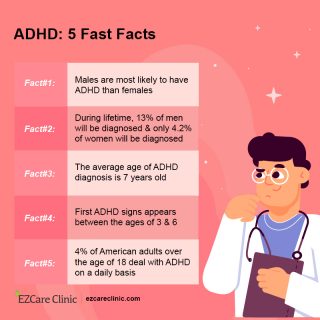
ADHD: 5 Fast Facts
What Is NEBA, and What Benefits Does It Offer ?
NEBA is a brain imaging technique approved by the Food and Drug Administration (FDA) to diagnose ADHD in children and adolescents.
It’s a non-invasive ADHD brain scan technique. A technician uses electrode discs to measure slow (theta) brain waves and fast (beta) brain waves. The discs are placed on the person’s scalp and join to a machine via wires. The machine amplifies the person’s brain waves, and a computer captures them.
The ratio of slow brain waves to fast brain waves is calculated and used in combination with a clinician’s assessment to determine if the person has ADHD. In a study involving more than 200 persons, NEBA, in combination with standard ADHD screening exams and questions, improved the accuracy of diagnosis from 61% to 88%. In most cases, a high ratio indicates ADHD.
Benefits of NEBA include:
- It is painless and safe.
- It captures the number of brain waves per second.
- It is FDA-approved for use in kids aged 6-7 years.
Manage ADHD and its symptoms effectively by clicking the button below!
What Are the Limitations of ADHD Brain Scans?
While brain scans seem appealing when it comes to diagnosing mental conditions, they are not without limitations.
Here is a look at some of the disadvantages of using brain scan in ADHD diagnosis:
-
Cost
Brain scans aren’t cheap. Hospitals, especially, charge more for brain scans than specialized facilities. The reason is that hospitals don’t do a lot of brain scanning but still have to maintain their equipment. A simple MRI can range between $250 -$12000 depending on the type of scan.
-
Radiation
Brain scans can expose children to harmful radiation. The more scans required, the higher the risk of exposure to great amounts of toxic rays.
-
Reduced sensitivity
The accuracy of brain scanning techniques reduces when you compare data between various ADHD patients.
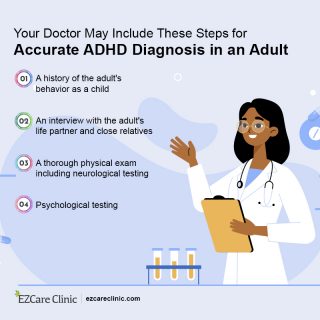
Your Doctor May Include These Steps for Accurate ADHD Diagnosis in an Adult
-
No accepted brain scan standards
There are no official standards on brain tests, thus limiting worldwide usage. Right now, brain scans for ADHD are more useful in research labs than for medical diagnosis purposes.
-
Lack of differential diagnosis
Brain scans only compare the brains of ADHD patients to those of healthy people to form conclusions, but other conditions with ADHD-like symptoms are not examined.
-
Cannot be carried out in patients with metallic implants
In case a person has got metallic implants such as dental implants, a brain scan is not possible; otherwise, it will reap body parts out.
Get ADHD tested now by clicking the button below!
Conclusion
Studies show that ADHD brains are different from healthy brains. Therefore, brain scans present appealing benefits in a firm diagnosis of the condition and subsequent treatments. People tend to believe what they can see.
Brain scans make patients comply with treatment, overcome shame, and adopt healthy lifestyles. Still, brain scan methods are not without disadvantages. Go for an FDA-approved ADHD brain scan to avoid issues.
Contact us or visit EZCare Clinic now for proper ADHD diagnosis and ADHD treatment now!
Sources
- Neuroimaging of Attention-Deficit/Hyperactivity Disorder: Current Neuroscience-Informed Perspectives for Clinicians. (2013)
Source link
